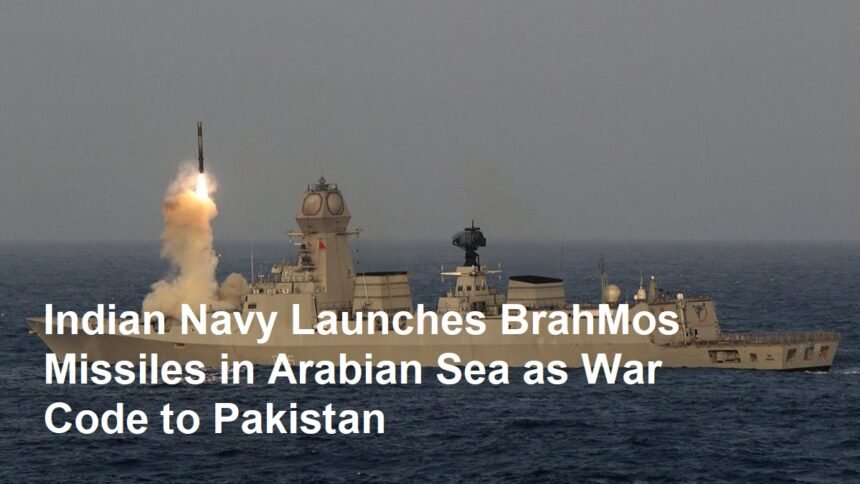On 27 April 2025, the Indian Navy conducted multiple ship-launched firings of the BrahMos supersonic cruise missile in the Arabian Sea, in what officials described as a coded demonstration of deterrence toward neighbouring Pakistan. The live-fire drills, carried out during routine operational exercises, were explicitly framed as a signal of “combat readiness” in the face of escalating tensions along the western maritime frontier.
Visual footage released by the Navy on social media showed BrahMos missiles streaking across the sky before striking mock targets at sea. The launches involved a mix of frontline platforms, including Kolkata-class destroyers and Nilgiri-class and Krivak-class frigates. According to the Navy’s spokesperson, these vessels undertook “successful multiple anti-ship firings to revalidate and demonstrate readiness of platforms, systems and crew for long-range precision offensive strike”.
In an online statement posted on the official ‘X’ account, the Indian Navy declared:
“Indian Navy stands Combat Ready, Credible and Future Ready — Anytime, Anywhere, Anyhow.”
This motto underscores a shift toward more assertive maritime posturing in response to what New Delhi characterises as “persistent threats to national security” emanating from Pakistan and its non-state proxies.
The missile firings occurred against a backdrop of reciprocal warnings. Pakistan’s maritime authorities had issued a Notice to Airmen and Mariners (NOTAM) and declared a limited no-fly zone over parts of the Arabian Sea on 24 and 25 April, ostensibly as a precautionary measure amid speculation of Indian military action. Islamabad also deployed additional naval assets off its southern coast in anticipation of any escalation.
The BrahMos missile, co-developed by India’s Defence Research and Development Organisation (DRDO) and Russia’s NPO Mashinostroyenia, travels at speeds up to Mach 2.8 (nearly three times the speed of sound) and has an operational range of approximately 290–300 km. Its supersonic profile and sea-skimming capability make it exceptionally difficult to intercept, enhancing India’s ability to project power in the Indian Ocean Region.
Defence analysts view these drills as part of a broader Indian strategy to maintain credible sea-based deterrence. “Precision strike capability at sea is vital for maintaining deterrence and securing national interests,” a senior naval officer told ThePrint, noting that such displays “send a clear message of maritime dominance and deterrence” without crossing the threshold into open conflict.
From Islamabad’s perspective, the BrahMos firings constitute a provocative escalation. Pakistani military commentators warned that India’s show of force would “compel Pakistan to revise its own naval deployments and rules of engagement in the Arabian Sea,” potentially increasing the risk of unintended maritime confrontations. Both sides are said to be monitoring shipping lanes closely, raising concerns about freedom of navigation for commercial traffic in one of the world’s busiest sea routes.
The April 27 exercises mark the most overt use of BrahMos in a signalling role since its induction into the Navy fleet. While New Delhi insists that the drills were pre-planned and part of regular training, regional security observers caution that such high-visibility actions carry inherent risks of miscalculation. As both navies remain on heightened alert, the Arabian Sea has emerged as a potential flashpoint in the simmering India-Pakistan rivalry.
Whether these missile firings will succeed in deterring future provocations or simply deepen mistrust remains to be seen. For now, New Delhi has left little doubt that it is prepared to leverage its advanced maritime strike capabilities to defend its interests “anytime, anywhere,” even as Islamabad vows to respond in kind.









